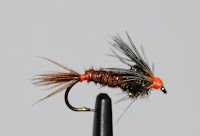After finally unpacking the moving boxes, I had a couple of hours to kill and decided to see what some of the PA creeks close by had to offer. I went out with my 10' 3 wt. Streamflex and figured I've bust out some of the coils from last year.
Fishing was slow to start. There were a couple of guys using worms and corn that I passed by, none having any reel luck. I threw on a soft hackled pink AC worm and an extended red bodied nymph AKA the good old San Juan. On my first drift I managed to hook into a nice fat rainbow. I knew I was in trouble when I heard "CRACK". My rod must have had a crack in it and that's all it took. I did manage to land the fish and was kicking myself for not bringing a second rod with me. The rod broke a couple inches above the cork, and I figured that I could either go home and cry about it, or keep on fishing. I tucked the reel into my waders and started casting my now 8'6" streamflex. I did manage a couple more fish which made the day bearable and I guess I'll be calling Greys tomorrow. Such a bummer as I was in Lancaster yesterday. All but one took the AC Worm.
 |
| Weird, but this fish's belly was really soft, almost empty. |
 |
| The new "5" piece |
*Well I thought that I would add that I contacted Greys/Hardy on Monday and they managed to ship out a new butt section so that I would be able to have it with me for my trip to the Catskills this coming weekend. With a broken butt section, the rod maker inside me started to wonder what could be done. I stuck the handle and reel seat into a pot of boiling water (even a heat gun will burn cork) to loosen it from the glue and epoxy. 10 minutes later I was able to slide off the cork grip with minor damage. The cork rings came apart in a couple of sections, but that can easily be fixed with wood glue. I used my caliper to determine the correct bore size for the "new" butt section and then drilled out the remaining graphite blank that was still in there. After some epoxy and wood glue to secure the hardware, voila!
I now have a perfect 9' 3 wt. Once the new butt section arrives, I'll be able to have a 10' 3 wt. that can be adjusted to 9' when space is an issue. If anyone has any questions on how to do this fix (you may have a broken rod laying around) let me know.









































